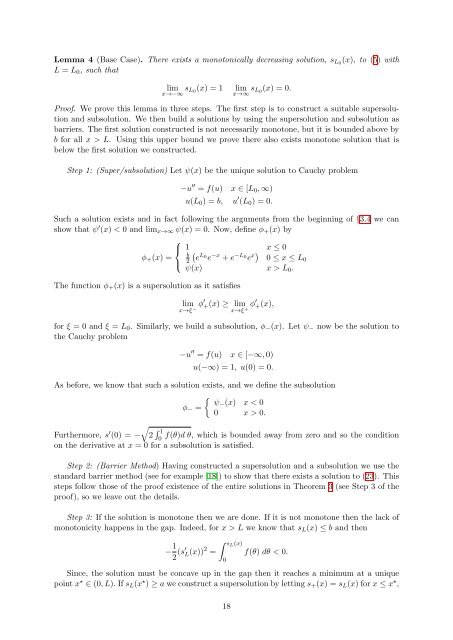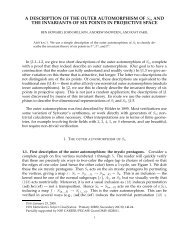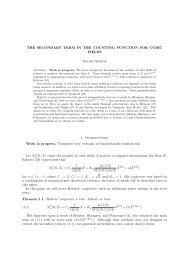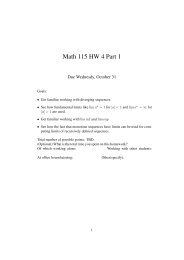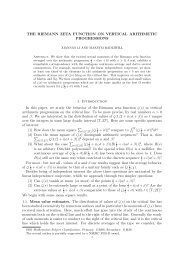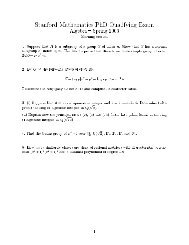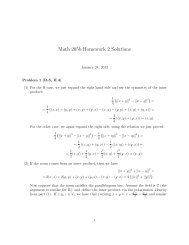Traveling Wave Solutions in a Reaction-Diffusion Model for Criminal ...
Traveling Wave Solutions in a Reaction-Diffusion Model for Criminal ...
Traveling Wave Solutions in a Reaction-Diffusion Model for Criminal ...
You also want an ePaper? Increase the reach of your titles
YUMPU automatically turns print PDFs into web optimized ePapers that Google loves.
Lemma 4 (Base Case). There exists a monotonically decreas<strong>in</strong>g solution, sL0 (x), to (5) with<br />
L = L0, such that<br />
lim sL0 (x) = 1 lim sL0 (x) = 0.<br />
x→−∞ x→∞<br />
Proof. We prove this lemma <strong>in</strong> three steps. The first step is to construct a suitable supersolution<br />
and subsolution. We then build a solutions by us<strong>in</strong>g the supersolution and subsolution as<br />
barriers. The first solution constructed is not necessarily monotone, but it is bounded above by<br />
b <strong>for</strong> all x > L. Us<strong>in</strong>g this upper bound we prove there also exists monotone solution that is<br />
below the first solution we constructed.<br />
Step 1: (Super/subsolution) Let ψ(x) be the unique solution to Cauchy problem<br />
−u ′′ = f(u) x ∈ [L0, ∞)<br />
u(L0) = b, u ′ (L0) = 0.<br />
Such a solution exists and <strong>in</strong> fact follow<strong>in</strong>g the arguments from the beg<strong>in</strong>n<strong>in</strong>g of §3.4 we can<br />
show that ψ ′ (x) < 0 and limx→∞ ψ(x) = 0. Now, def<strong>in</strong>e φ+(x) by<br />
⎧<br />
⎨ 1<br />
<br />
x ≤ 0<br />
b L0 φ+(x) =<br />
⎩ 2 e e−x −L0 + e ex 0 ≤ x ≤ L0<br />
ψ(x) x > L0.<br />
The function φ+(x) is a supersolution as it satisfies<br />
lim<br />
x→ξ− φ′ +(x) ≥ lim<br />
x→ξ + φ′ +(x),<br />
<strong>for</strong> ξ = 0 and ξ = L0. Similarly, we build a subsolution, φ−(x). Let ψ− now be the solution to<br />
the Cauchy problem<br />
−u ′′ = f(u) x ∈ [−∞, 0)<br />
u(−∞) = 1, u(0) = 0.<br />
As be<strong>for</strong>e, we know that such a solution exists, and we def<strong>in</strong>e the subsolution<br />
<br />
ψ−(x) x < 0<br />
φ− =<br />
0 x > 0.<br />
Furthermore, s ′ <br />
(0) = − 2 1<br />
0 f(θ)d θ, which is bounded away from zero and so the condition<br />
on the derivative at x = 0 <strong>for</strong> a subsolution is satisfied.<br />
Step 2: (Barrier Method) Hav<strong>in</strong>g constructed a supersolution and a subsolution we use the<br />
standard barrier method (see <strong>for</strong> example [18]) to show that there exists a solution to (23). This<br />
steps follow those of the proof existence of the entire solutions <strong>in</strong> Theorem 3 (see Step 3 of the<br />
proof), so we leave out the details.<br />
Step 3: If the solution is monotone then we are done. If it is not monotone then the lack of<br />
monotonicity happens <strong>in</strong> the gap. Indeed, <strong>for</strong> x > L we know that sL(x) ≤ b and then<br />
− 1<br />
2 (s′ L(x)) 2 =<br />
sL(x)<br />
0<br />
f(θ) dθ < 0.<br />
S<strong>in</strong>ce, the solution must be concave up <strong>in</strong> the gap then it reaches a m<strong>in</strong>imum at a unique<br />
po<strong>in</strong>t x ⋆ ∈ (0, L). If sL(x ⋆ ) ≥ a we construct a supersolution by lett<strong>in</strong>g s+(x) = sL(x) <strong>for</strong> x ≤ x ⋆ ,<br />
18


